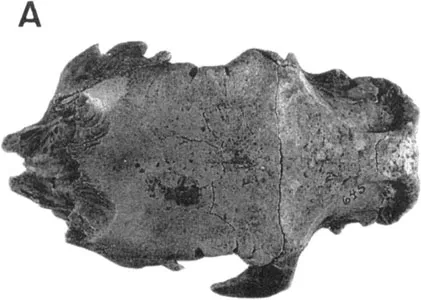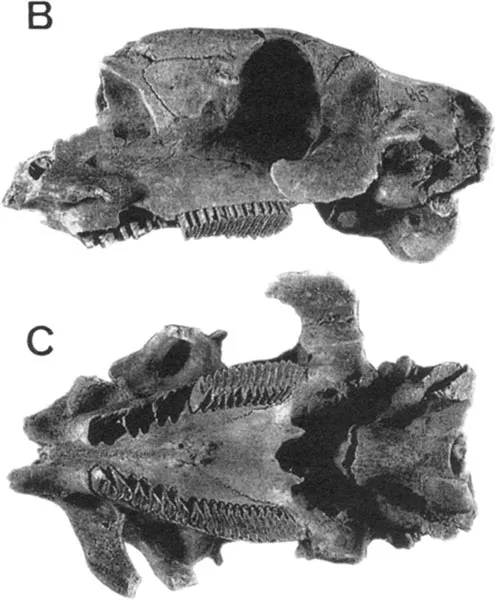
eBook - ePub
Quaternary of South America and Antarctica Peninsula 1998
Jorge Rabassa, Monica Salemme, Jorge Rabassa, Monica Salemme
This is a test
Buch teilen
- 328 Seiten
- English
- ePUB (handyfreundlich)
- Über iOS und Android verfügbar
eBook - ePub
Quaternary of South America and Antarctica Peninsula 1998
Jorge Rabassa, Monica Salemme, Jorge Rabassa, Monica Salemme
Angaben zum Buch
Buchvorschau
Inhaltsverzeichnis
Quellenangaben
Über dieses Buch
This text deals with certain geological aspects of the extreme geographical locations of South America and the Antarctic Peninsula. Topics include: Brazil - geology and vertebrate paleontology; pleistocene wave-built terraces of Northern Rio de Janeiro state; and holocene coastal evolution.
Häufig gestellte Fragen
Wie kann ich mein Abo kündigen?
Gehe einfach zum Kontobereich in den Einstellungen und klicke auf „Abo kündigen“ – ganz einfach. Nachdem du gekündigt hast, bleibt deine Mitgliedschaft für den verbleibenden Abozeitraum, den du bereits bezahlt hast, aktiv. Mehr Informationen hier.
(Wie) Kann ich Bücher herunterladen?
Derzeit stehen all unsere auf Mobilgeräte reagierenden ePub-Bücher zum Download über die App zur Verfügung. Die meisten unserer PDFs stehen ebenfalls zum Download bereit; wir arbeiten daran, auch die übrigen PDFs zum Download anzubieten, bei denen dies aktuell noch nicht möglich ist. Weitere Informationen hier.
Welcher Unterschied besteht bei den Preisen zwischen den Aboplänen?
Mit beiden Aboplänen erhältst du vollen Zugang zur Bibliothek und allen Funktionen von Perlego. Die einzigen Unterschiede bestehen im Preis und dem Abozeitraum: Mit dem Jahresabo sparst du auf 12 Monate gerechnet im Vergleich zum Monatsabo rund 30 %.
Was ist Perlego?
Wir sind ein Online-Abodienst für Lehrbücher, bei dem du für weniger als den Preis eines einzelnen Buches pro Monat Zugang zu einer ganzen Online-Bibliothek erhältst. Mit über 1 Million Büchern zu über 1.000 verschiedenen Themen haben wir bestimmt alles, was du brauchst! Weitere Informationen hier.
Unterstützt Perlego Text-zu-Sprache?
Achte auf das Symbol zum Vorlesen in deinem nächsten Buch, um zu sehen, ob du es dir auch anhören kannst. Bei diesem Tool wird dir Text laut vorgelesen, wobei der Text beim Vorlesen auch grafisch hervorgehoben wird. Du kannst das Vorlesen jederzeit anhalten, beschleunigen und verlangsamen. Weitere Informationen hier.
Ist Quaternary of South America and Antarctica Peninsula 1998 als Online-PDF/ePub verfügbar?
Ja, du hast Zugang zu Quaternary of South America and Antarctica Peninsula 1998 von Jorge Rabassa, Monica Salemme, Jorge Rabassa, Monica Salemme im PDF- und/oder ePub-Format sowie zu anderen beliebten Büchern aus Biological Sciences & Evolution. Aus unserem Katalog stehen dir über 1 Million Bücher zur Verfügung.
Information
1
The presence of Neochoerus Hay, 1926 (Rodentia, Hydrochoeridae) in Pleistocenic sediments of Southwestern Buenos Aires Province, Argentina
Comisión de Investigaciones Científicas (CIC) & Departamento Paleontología Vertebrados, Museo de La Plata, La Plata, Argentina.
ABSTRACT: An almost complete skull of Neochoerus sp. (Rodentia, Hydrochoeridae) from Bajo San José (lat. 38°34′S, southwestern Buenos Aires province, Argentina) is described. The bearing unit is considered of Ensenadan Land-Mammal Age (Early-Middle Pleistocene). This is the record of highest latitude of the genus, and of the Family Hydrochoeridae since the end of the Pliocene. Bajo San José is placed in the border between two zoogeographic subregions. The presence of Neochoerus at this latitude can be taken as an example of the historical dynamism of the Pampasic fauna during the Quaternary, which was signed by the strong climatic changes characteristic of the Pleistocene. The accompanying fauna is conformed by genera or species inhabiting today under either more humid and temperate conditions or more arid ones than those of the area of Bajo San José. The former may suggest more arid conditions than today for this area, and the latter, may either be relict forms of more humid and warmer prior conditions, or indicate environmental changes towards higher temperature and humidity which favoured their southern dispersion along rivers and streams.
RESUMEN: Se describe un cráneo casi completo de Neochoerus sp. (Rodentia, Hydrochoeridae), hallado en Bajo San José (lat. 38°34′S, sudoeste de la provincia de Buenos Aires, Argentina). La unidad portadora es considerada de Edad Ensenadense (Pleistoceno temprano-medio). Este es el registro más austral del género y de la Familia Hydrochoeridae desde el fin del Plioceno. Bajo San José está ubicado en el límite entre dos subregiones zoogeográficas. La presencia de Neochoerus en esta latitud puede tomarse como un ejemplo del dinamismo histórico de la fauna pampásica durante el Cuaternario, caracterizado por los grandes cambios climáticos del Pleistoceno. La fauna acompañante está compuesta por géneros o especies que habitan en la actualidad zonas más áridas o más húmedas y templadas que las del área de Bajo San José. Las primeras pueden sugerir condiciones más áridas que las actuales de esta zona, y las últimas, pueden ser tanto formas relictuales de condiciones más húmedas y cálidas previas, como indicar cambios ambientales hacia condiciones de mayor temperatura y humedad que habrían favorecido su dispersión hacia el sur a lo largo de ríos o arroyos.
1 INTRODUCTION
New remains of Neochoerus are described in this paper, coming from Bajo San José (Coronel Pringles county, Southwestern Buenos Aires province, Argentina). A preliminary list of the fossil fauna found in this locality was published by Deschamps & Borromei (1992); fish remains were studied by Cione & Lopez Arbarello (1993), and the sigmodontine rodents by Pardinas & Deschamps (1996). The fossil-bearing unit outcrops at both margins of the Sauce Grande river, being the best site a gravel quarry located near the bridge of the National Route 51 over this river (lat. 38°34′ S, long. 61°41′ W), 51 km northeast of the city of Bahia Blanca (Fig. 1). The geological setting has been discussed in Borromei (1989) and Deschamps & Borromei (1992), in whose papers the entire sequence was attributed to a Pleistocene deposit originated by a gravelly braided stream system. Deschamps (1995) assigned this deposit to the Ensenadan (Early-Middle Pleistocene) Land-Mammal Age (Pascual et al. 1965, Cione & Tonni 1995).

Figure 1. Location map.
2 MATERIAL AND METHODS
The fossil material herein described has been compared with skulls of Hydrochoerus hydrochaeris (‘carpincho’): MLP 650, MLP 1406, MLP 14-IX-55-1 and MLP 18-VIII-92–16 from the Departamento de Zoología Vertebrados, 43 and 427 from the Departamento de Paleontología Vertebrados, Museo de La Plata, La Plata, Argentina, and with the following fossil specimens from Museo Argentino de Ciencias Naturales ‘Bernardino Rivadavia’ (MACN), Buenos Aires, of related genera: MACN: 16688, 5302, 5313, 587 and 588.
The ontogenetic stage of this specimen was estimated following Mones (1991: 96, Fig. 12) who proposed five classes of ages (Ages 0–4) taking into account the ossifying sequence of the basicranium.
3 SYSTEMATICS
Family HYDROCHOERIDAE Gray, 1825
Subfamily HYDROCHOERINAE Gray, 1825
Genus Neochoerus Hay, 1926 Neochoerus sp. (Fig. 2 A, B, C)
Material: UNSGH (Universidad Nacional del Sur, Geología Histórica) 645: part of the skull with right P4-M3 and left M3.
Description: It is a very well preserved skull, though without the rostrum and part of the zygomatic arches. It is a young specimen of age 2 since its exoccipital-basioccipital and basisphenoid-presphenoid (Ages 1 and 2) sutures are ossified, but not its exoccipital-supraoccipital and basioccipital-basisphenoid ones (Ages 3 and 4 respectively). Its size is approximately 20% larger than that of the single living species and genus Hydrochoerus hydrochaeris (see Table 1). Consequently, it can be accepted that when adult, it could have reached the size of the species of the genus Neochoerus, that is, a third to half larger than the living species.

Figure 2. Skull of Neochoerus sp. UNSGH 645. a) Upper view.

Figure 2. b) Lateral view, c) Lower view. Scale: 5 cm.
Neochoerus sp. UNSGH 645 | H. crespoi MACN-16688 | H. dasseni MACN-5302 | N. tarijensis MACN 587–588 | H. hydrochaeris (six skulls) | ...
|---|